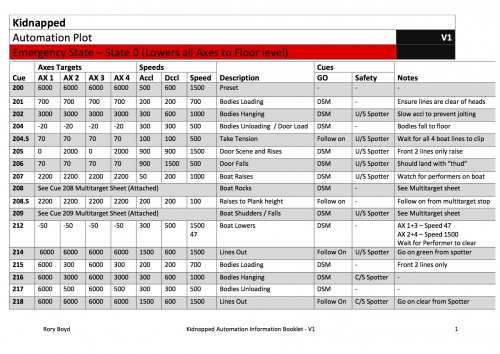Kidnapped
| Kidnapped | |||||||||||||||||||||||||||||||||||||||||||
|---|---|---|---|---|---|---|---|---|---|---|---|---|---|---|---|---|---|---|---|---|---|---|---|---|---|---|---|---|---|---|---|---|---|---|---|---|---|---|---|---|---|---|---|

| |||||||||||||||||||||||||||||||||||||||||||
Kidnapped is a production done in partnership with the National Theatre of Scotland. It is a new adaptation of Robert Louis Stevenson's novel of the same name. Director and designer Graham McLaren stated that his goal was to have a 60 minute show of non-stop action and minimal dialogue. The cast of BA Acting 3 students played a large part in helping to develop and cut the script.
Cast List
David: Rebekah Lumsden/Sarah Miele
Ebenezer: Nicholas Barton-Wines
Hoseason: Shane Murphy/Bobby Ginty
Riach: Thierry Mabonga
Alan: Jacob Vigeland/Laurie Scott
Peter: Emilie Konradsen
Maclean: Charlotte Driessler
Red Fox: Alex Kampfer
James: Tim Pollack
Cluny: Jamie Hughes
Rankeillor: Stephen Moseley
Props
--Paperback copies of "Kidnapped" x12 (Sourced from several Glasgow and Edinburgh bookstores as well as borrowed personal copies)
--Industrial lantern torches x6 (Purchased from Amazon)
--Nerf guns x6 (Borrowed from students/purchased at Hamley's)
--Disk firing guns x2 (Purchased at Hamley's)
Production Details
The set consists of a large cube of truss from the National Theatre of Scotland. From the truss hang several harnesses and pulley systems creating an elaborate flying system operated by crew members Stuart Leech, Calum Paterson, Ross McCrone, and overseen by TSMs Daniel Thompson and Rory Boyd. An external training team from Aerial Edge was brought in to train the crew on the safe and proper use of the counterweight flying system. For the actual performances, the actors acted as each other's counterweights and the crew were trained in emergency rescue operations but no longer acted as bases.
Sound Design
The sound system for Kidnapped was made up of two PA’s, one for music and one for vocals.
The vocal PA was made of two d&b C6s on the downstage truss legs, two d&b E9s and two d&b C7-SUBS behind the upstage truss legs. The music PA was made of four d&b Q7s on a truss bar above the platform, two d&b C6s behind the audience of the fly cages and two stacks of QSUBS under the platform.
The sound, light and automation control positions for Kidnapped were on the platform behind the PA, this caused difficulties with mixing the show as it was difficult for the operator to hear. We added a small FOH monitor next to the control position to overcome these issues.
Fourteen Countryman H6 radio mics were used in this production which caused difficulties with EQ-ing and creating a natural sound due to the show being a somewhat "in the round" piece.
One mic had constant drop outs during the wall scene of Kidnapped. This was due to an RF issue not reaching the cast member's pack from where the aerial position was. After repositioning the panels, issues ceased.
Automation
This production used Automation very heavily.
Both Set pieces and performers were flown using the Winches. The main set piece was 2m x 1.3m door, that was clipped onto a winch at each corner.
This 'door' was then flown up to form a boat. It supported the weight of up to 5 performers at one time, all of which were not clipped onto a safety. It did however feature large handles all around the sides of the top surface.
Cues
There were 17 cues during the show, and they started at 200. 2 of the cues were multi-targets. Please see the Automation plot below:
Cues 8 and 9 used Multitargets.
Cue 8 was the boat rocking, and cue 9 was how the boat shook and dropped.
Descriptions on how both of these cues were run can be found here.
Safety
There were several safety measurers put in place for the operation of the Automation. As the operator could not always see the ends of the lines, spotters were located throughout the venue. The main spotter was situated Upstage, and had wireless cans. The main communication method however was a red and green torch. When it was safe to operate, a green torch was given. This made it a lot easier for the operator as it only took a glance, compared to having to ask on cans. It also made it a lot easier for the spotter to sat it was not safe, by just holding a red. When crew clipped people or set onto the lines, they individually raised their hands when their winch was safe. This would then be collated by the Upstage spotter, who would pass on a green light to the operator.
This method worked flawlessly during rehearsals and the performances, and proved and extremely reliable method to giving safetys.



